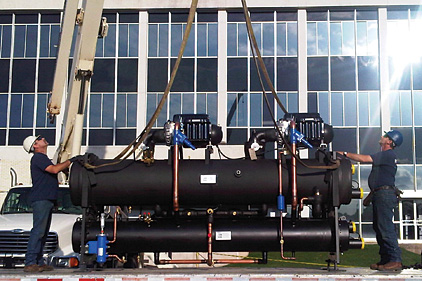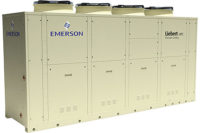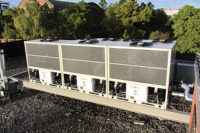Last December, the General Services Administration (GSA) released a report describing its test-bed installation of variable-speed maglev compressor technology in a chiller plant in a government building in Pine Bluff, Arkansas. But this isn’t just a simple case study, according to Kevin Powell, director of GSA’s Green Proving Ground (GPG) program.

|
| As part of a Green Proving Ground research project, the General Services Administration installed a new variable-speed maglev chiller in the George Howard Jr. Federal Building and U.S. Courthouse in Pine Bluff, Arkansas. The chiller’s performance was then monitored for a six-month period. |
“This is not a case study saying this technology in this location did this thing, and that’s all we know,” Powell said. Instead, he explained, GSA’s Green Proving Ground program was established to research emerging building technologies with the goal of determining which ones have the potential to significantly impact the efficiency and sustainability of buildings.
When GPG issued its first call for technologies to research in January 2011, it received 147 submissions. Program administrators ultimately chose 16 technologies to review. One of those was magnetic levitation, or maglev, with a variable-speed drive on chiller efficiency.
“GSA’s real estate portfolio is largely comprised of larger buildings, so the predominant type of cooling that we have is a chiller plant on a rooftop unit. Given that, we thought there was a significant opportunity if these performance claims for the variable-speed maglev technology really proved out,” Powell said.
Maglev Technology
In 2011, Powell noted, maglev technology had not received much exposure in the industry. “Three years ago, these chillers would be characterized as an emerging technology,” he said. “[They] didn’t have a whole lot of market share, but had some really dramatic performance claims.” Powell explained that the savings projected by the compressors are mainly due to their oil-free magnetic bearings, fully integrated variable-speed drives, and digital controls with microprocessors that manage compressor operation.
“The key difference is that rather than using bearings and oil, you’re using magnetic levitation in the compressor,” he said, noting that the lack of metal-on-metal contact reduces inefficient heat loss caused by friction, allowing for highly efficient chiller operation at partial load.
Test Site
After GPG decided to research the impact of this technology, it set up a test case at the George Howard Jr. Federal Building and U.S. Courthouse in Pine Bluff, Arkansas.
Powell explained that this test site’s chiller plant was perfect for GPG’s research because it had two chillers, and only one needed to be replaced.
“The building had a unique situation. It had two rotary screw chillers [with the same tonnage], one of which had reached the end of its life and one of which was actually in very good repair,” he said. “So that gave us a great opportunity to do a side-by-side comparison.”
In February 2012, GSA replaced one of the chillers with a new chiller that included two variable-speed maglev compressors manufactured by Danfoss Turbocor. According to Powell, although more manufacturers have since introduced maglev products to the market, when the project was initiated in 2011, Danfoss was the only manufacturer producing compressors with variable-speed maglev technology.
After the equipment was installed, GPG tasked the Pacific Northwest National Laboratory (PNNL), a Department of Energy (DOE) lab, with monitoring the performance of both chillers and analyzing their efficiency. PNNL monitored both chillers for a period of six months from March through September 2012.
According to GPG’s report, “PNNL employed an independent data acquisition system that scanned meters and sensors every second to generate a comprehensive dataset of chiller performance. Chiller efficiency was measured with the coefficient of performance — the ratio of cooling energy provided to the amount of energy consumed. The amount of electricity demanded by each chiller was also measured and recorded. Weather data was gathered and normalized to project the performance of the chillers over a typical meteorological year.”
Efficiency Results
After the research was concluded and analyzed, GPG released its report on variable-speed maglev chillers in December 2013. The findings stated that the chiller achieved energy savings of 42 percent in comparison to the existing chiller on the site. (See sidebar for more details from the report.)
“It slightly exceeded the manufacturer’s claims, so that was better than we expected,” Powell said.
He added that PNNL normalized the weather data so that GPG could make a broad recommendation based on this study.
“What we’re trying to do is go from a very specific instance to a broad recommendation,” he said. “[The report] is saying that this technology, as we evaluated it, has a generalized performance claim, and we have confidence that that performance claim is real, and it would be true across our portfolio.”
As a result of this GPG research project, GSA’s report recommended “targeted deployment of this technology as an end-of-life replacement for chillers with rotary screw compressors.” Powell explained, “This has to do with the fact that we serve the taxpayer, and we pursue projects that make financial sense. And in this case, there is good payback for this technology at end of life.”
Broad Implications
Because of the success of the research at the Arkansas test site, GSA has now begun to deploy variable-speed maglev compressor technology in its chiller plants in four other locations across the country. Powell noted that while any research conducted at these facilities will not be as formal as the Arkansas study, there will be an ongoing effort to track the efficiency achieved with the new technology to ensure that it is in line with GSA’s expectations.
Because the recommendation is only for end-of-life replacement, the hope is that implementing this technology will result in a gradual greening of chillers across GSA’s facilities. Additionally, Powell said that GPG also intends for its research to go beyond simply enabling greater efficiency within GSA’s portfolio.
“Part of what our program hopes to do is to establish the performance for a type of technology to hopefully encourage a robust marketplace for that type of technology,” he said. “We want to leverage that federal portfolio and take a federal leadership role, but the overarching view is that we’re looking to improve the market for everybody.”
SIDEBAR: GSA Report Findings
GSA published the following findings on variable-speed maglev chiller efficiency, based on the six-month study conducted at the Pine Bluff, Arkansas, site.
• High Efficiency at Low Cooling Loads: The variable-speed maglev chiller compressor achieved energy savings of 42 percent, due in large part to the regularity with which chillers operate at partial load. The variable-speed drive allows the chiller to perform at higher efficiency at lower and partial cooling loads, compared with standard chillers with less flexibility in operational speed and power. During a testing period with above-average outside temperatures, the operating chiller spent 80 percent of the time operating at a load factor below 50 percent. As cooling load factors decrease, the efficiency of magnetic levitation compressors becomes more pronounced.
• Reduced Long- and Short-Term Maintenance: The rotating shaft of the new compressor is levitated with magnetic bearings, thus eliminating the metal-on-metal contact of conventional bearings. In addition to increasing efficiency, the elimination of friction removes the need for lubricating oil and the ancillary components required to support the oil system. The new compressor also features a “soft-start” capability to reduce start-up stresses that contribute to long-term maintenance issues.
• Smaller Size and Quieter Performance: Though the physical footprint of the centrifugal chiller remains similar to that of conventional chillers, maglev compressors are smaller and lighter than other compressor types of similar capacity. The new compressors also run very quietly, allowing chiller plants to be located closer to occupant spaces.
– Source: www.gsa.gov/gpg
Publication date: 5/12/2014
Want more HVAC industry news and information? Join The NEWS on Facebook, Twitter, and LinkedIn today!








